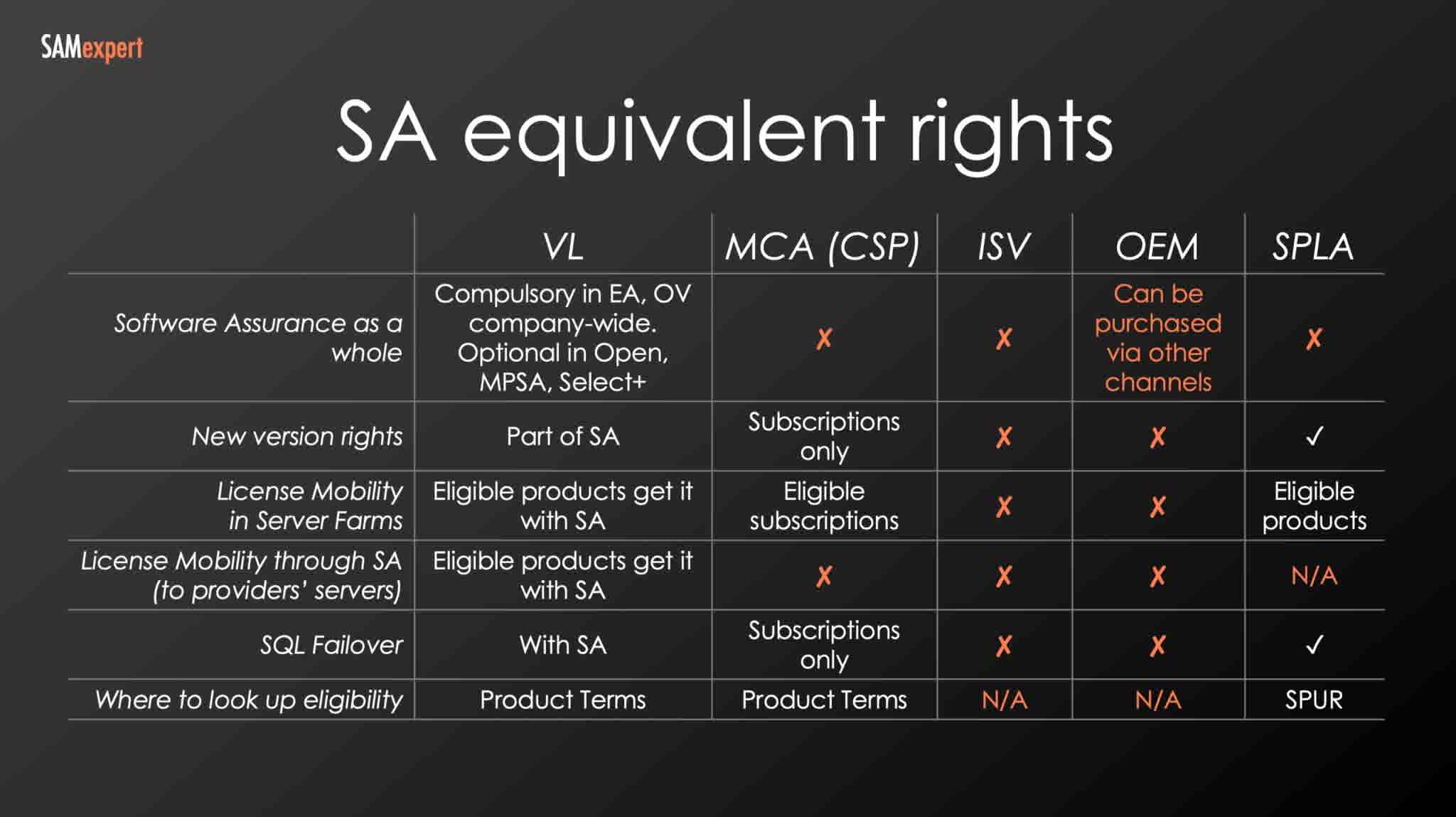Summary
Microsoft Software Assurance is often seen as an upgrade right only. However, it is a dangerous misconception. Let your SA lapse, and you may need to change how you do your entire IT.
What is Software Assurance, in simple terms?
Software Assurance is a subscription offered in addition to Microsoft software licences. It includes extended licensing rights: upgrade rights, license mobility, unlimited virtualisation, and more, depending on the product.
Microsoft also used to provide non-licensing benefits through Software Assurance: training vouchers, deployment vouchers etc.; however, these benefits have been gradually taken away.
SA is what other software vendors call "maintenance"
Some vendors may package additional rights with maintenance. Almost every vendor includes the right to upgrade, which permits upgrading to a new version during active maintenance. Microsoft also packages rights to upgrade your software to the latest version with their Software Assurance.
For example, assume that you bought SQL Server licenses with Software Assurance in 2017. At the time, the current version was SQL Server 2017. Let's also imagine you had an Enterprise Agreement and paid for maintenance for three years in annual instalments.
Comes 2019, Microsoft releases a new version of SQL Server – SQL 2019. By the right granted to you through Software Assurance, you could upgrade to SQL Server 2019. You did not have to upgrade, as it is not an obligation.
Software Assurance is more than just upgrades
But please remember that Software Assurance is a much bigger package. Microsoft evangelists may get offended if you say that Software Assurance is only a right to upgrade. It's not.
And there is more! If you're paying Microsoft for Software Assurance – an ongoing cost – you must be given something in return. There is a whole list of additional licensing benefits, product-dependent.
Software Assurance is unavailable in some Microsoft Agreements
Generally, Software Assurance is only available via traditional Volume Licensing agreements like Microsoft Enterprise Agreement, MPSA, or Open Value. Microsoft CSP provides partial equivalency.
Please check the table below for Software Assurance availability in Microsoft licensing channels.

Warning: Watch for your Software Assurance expiration!
I almost guarantee you that you are using benefits granted by Software Assurance in your IT and maybe even your Cloud. Do not let your Software Assurance coverage lapse!
We often get asked, "Can we cancel our Enterprise Agreement?" Of course, you can, but you might have to rebuild your entire infrastructure.
Before cancelling your Enterprise Agreement, you must make critical, strategic decisions. What are you going to do with the Software Assurance benefits that you're going to lose?
You can renew Software Assurance in another licensing program or subscribe for licenses. There are ways to deal with it, but if your only reason to cancel an EA was to get rid of the annual maintenance, then I'm afraid you might need to reconsider.
What are you losing in addition to the right to upgrade?
Well, firstly, License Mobility in Server Farms and Flexible Virtualisation. Without Software Assurance, you may have to shut down your VMware, Hyper-V, and Nutanix clusters.
Virtual machines move around in clusters. It is the core nature of virtual clustering, its core feature. But your licenses have lost the right to move with the virtual machines, thus making your entire virtualised estate non-compliant!
Your only way out of this misery is to acquire subscription licenses or re-purchase perpetual licenses with Software Assurance.
What are the other things you get through SA? License Mobility through Software Assurance and Flexible Virtualization.
The former is a bit confusing. There is License Mobility in Server Farms, and then there is License Mobility through Software Assurance. These two are not the same. I have explained the former above. Let's talk about the latter.
When you rent virtual machines from Amazon AWS, Google Cloud, or a regular hosting provider with a Service Provider License Agreement, you might want to deploy additional software in the rented virtual machines.
The default payment option for additional software is pay-as-you-go (or pay-as-you-use). However, there is also an option to use your existing licences ("Bring-your-own-license", BYOL), which is often less expensive in the long run. That option is only available to you when your licenses have License Mobility through Software Assurance or Flexible Virtualization (subject to their own terms, conditions and limitations).
SQL Server 2022 requires Software Assurance to run on a virtual machine.
And there's also the other benefit of Software Assurance, which only works in Azure – Azure Hybrid Benefit. It provides even more significant cost avoidance potential than BYOL described above. Some licenses even permit simultaneous use on-premises and in Azure! But this benefit, again, only comes with Software Assurance.
Now, imagine if your Software Assurance lapses. What are you going to do then?
If you want your workloads to be virtualised in a dynamic, hyper-converged environment, if you're going to license your Microsoft software properly for that environment, you have to cover it with Software Assurance.
Talk to a Microsoft licensing expert
We are an independent consulting business that sells no licenses or Cloud services. That is on purpose, so our advice is unbiased.
Would you like to discuss your Software Assurance situation? Please send us a message using the form below, and we'll get in touch as soon as possible.